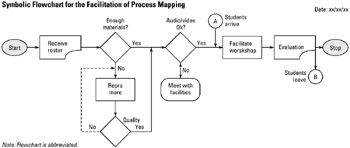Tool 146: Process Analysis
| AKA | N/A |
| Classification | Analyzing/Trending (AT) |
Tool description
The process analysis technique helps to trace the source of variation and is, therefore, a useful method to identify root causes of a problem. Process analysis is typically performed using an activity-level process flowchart and by asking a series of questions to explore or justify excessive cycle time, approvals, improper sequence, delays, and other process deficiencies.
Typical application
-
To review, analyze, and improve an existing process.
-
To identify process improvement opportunities.
-
To fine-tune processes in an organizational change project.
Problem-solving phase
| → | Select and define problem or opportunity |
| → | Identify and analyze causes or potential change |
| → | Develop and plan possible solutions or change |
| Implement and evaluate solution or change | |
| Measure and report solution or change results | |
| Recognize and reward team efforts |
Typically used by
| Research/statistics | |
| Creativity/innovation | |
| Engineering | |
| Project management | |
| 2 | Manufacturing |
| Marketing/sales | |
| 4 | Administration/documentation |
| 3 | Servicing/support |
| Customer/quality metrics | |
| 1 | Change management |
before
-
Symbolic Flowchart
-
Organization Chart
-
Process Mapping
-
Process Flowchart
-
Cycle Time Flowchart
after
-
Activity analysis
-
Variance Analysis
-
Work Flow Analysis (WFA)
-
Facility Layout Diagram
-
Decision Process Flowchart
Notes and key points
-
To constuct a process flow, several tools are available:
-
process flowchart
-
symbolic flowchart
-
Process Mapping
-
cycle time flowchart
-
activity analysis
Using any one of these will allow a process improvement team to achieve established team goals.
-
-
The given list of 10 process analysis questions is optional. The number and content of questions may change in accordance with the complexity of any given process.
Step-by-step procedure
-
STEP 1 As a prerequisite activity, a facilitated team develops a process flowchart at the activity-level for the process selected.
-
STEP 2 A set of standard process analysis questions is displayed by the facilitator. The team reviews the questions, adds, deletes, or revises questions to fully cover the process to be analyzed.
-
STEP 3 Using the finalized list of questions, the team discusses all activities in the process and provides responses to the questions.
-
STEP 4 Finally, the facilitator asks participants to recheck all responses, makes final revisions, and dates the list.
-
STEP 5 The information serves as an input to a variance analysis process, a logical next step for the team.
Example of tool application

| Typical Process Analysis Questions | Date: xx/xx/xx |
|---|---|
| |
EAN: 2147483647
Pages: 326
- Challenging the Unpredictable: Changeable Order Management Systems
- The Second Wave ERP Market: An Australian Viewpoint
- Enterprise Application Integration: New Solutions for a Solved Problem or a Challenging Research Field?
- The Effects of an Enterprise Resource Planning System (ERP) Implementation on Job Characteristics – A Study using the Hackman and Oldham Job Characteristics Model
- Context Management of ERP Processes in Virtual Communities